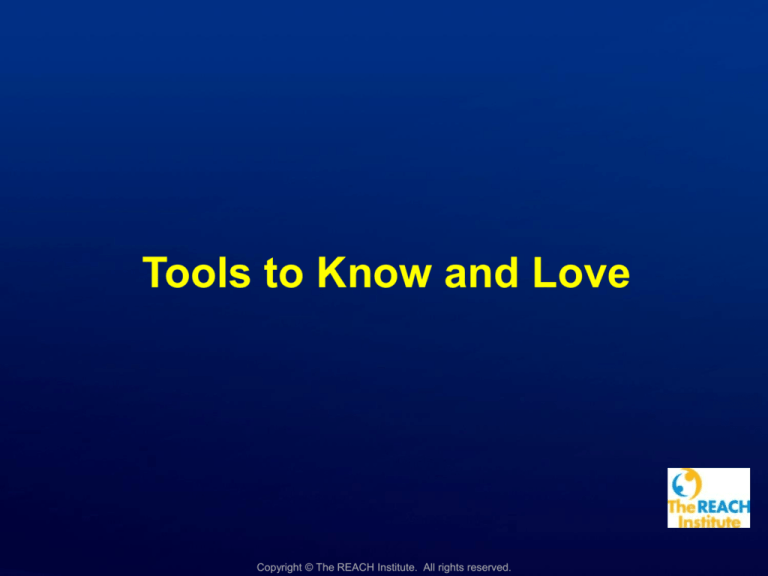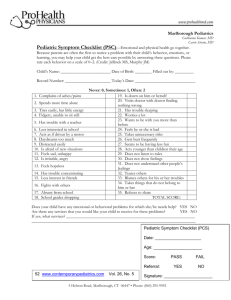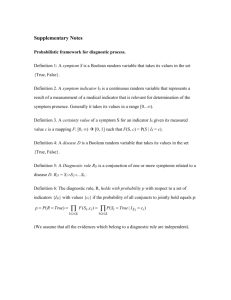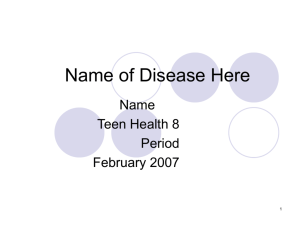
Tools to Know and Love
Copyright © The REACH Institute. All rights reserved.
Learning Objectives
• Distinguish the differences between tool
types
• State the advantages and disadvantages
of different types of tools
• Identify tools that might work in your
practice
• Use the Pediatric Symptom Checklist
(PSC)
Copyright © The REACH Institute. All rights reserved.
Screening Test
IS
• Used across populations
to identify issues in an
individual that need
further follow-up
IS NOT
• Diagnostic
• Best if brief, inexpensive,
can lead to intervention if
something is identified
• Better positive predictive
value with higher
prevalence
Examples: Pediatric
Symptom Checklist
(PSC), Screen for
Child Anxiety Related
Disorders (SCARED)
Copyright © The REACH Institute. All rights reserved.
Behavioral Checklist
IS
IS NOT
• Summary of a diverse set
of symptoms across
domains
• Brief
• Diagnostically based
• Specific enough to
confirm a diagnosis
Examples: Child Behavior
Checklist (CBCL), Behavior
Assessment System for
Children (BASC)
Copyright © The REACH Institute. All rights reserved.
Rating Scale
IS
IS NOT
• A questionnaire that
has been well-tested to
measure symptoms &
help predict a specific
diagnostic entity
• May (or may not) track
treatment response
• A diagnostic tool that will
provide a diagnosis
based on a score on a
rating scale
Example: Vanderbilt for
ADHD
Website Screening Tool and Rating Scale Reference:
http://www2.massgeneral.org/schoolpsychiatry/screeningtools_table.asp
Copyright © The REACH Institute. All rights reserved.
Diagnostic Test
IS NOT
IS
• Manualized
• Uses DSM-5 criteria to
review major disorders
• Short, brief
• Not useful in PC
settings
• Diagnostic
Example: Diagnostic
Interview Schedule for
Children (DISC IV)
Copyright © The REACH Institute. All rights reserved.
Pediatric Symptom Checklist (PSC)
• Psychosocial screen
• Designed for busy pediatrics office
• Widely used
• Time < 5 minutes
• English, Chinese, Spanish, other
• Cost: Free
Copyright © The REACH Institute. All rights reserved.
Pediatric Symptom Checklist (PSC)
• 17 item or 35 item formats
– PSC 17 or PSC 35
• 12% middle income children “screenin” or have positive scores; higher for
lower income children
• 17 item format is often sufficient
Copyright © The REACH Institute. All rights reserved.
Pediatric Symptom Checklist (PSC)
Parent and Youth versions
• Parent Version
– Parent C 1.2 & 1.6 Youth C 1.3 & 1.7
– Ages 4 and up
– Parent completes
Copyright © The REACH Institute. All rights reserved.
Pediatric Symptom Checklist
(PSC-17)
• Example: Youth Version of PSC
(PSC17-Y)
– C1.3
– Ages: used in studies with ages 9 and up
– Youth self-report
– Newer than original PSC-35
– Scoring same as parent form
Copyright © The REACH Institute. All rights reserved.
Scoring a PSC-17
Scoring – quick, easy
• C1.1
• Total score – used to “screen-in” or “screen-out” a child
• 3 subscale scores
– Attention
– Externalizing – disorders with “acting out” symptoms.
Example: conduct disorder
– Internalizing – disorders with “quieter” symptoms.
Example: anxiety, depression
Copyright © The REACH Institute. All rights reserved.
Scoring a PSC-17
• Each item is rated as “Never,” “Sometimes,” or
“Often” present and scored 0, 1, or 2,
respectively
• The total score is calculated by adding together
the score for each of the 17 items
– Positive PSC-17 score ≥ 15
• Attention, Externalizing, and Internalizing
subscale scores are calculated by adding the
score for each corresponding symbol:
= Attention, positive score ≥ 7
= Externalizing, positive score ≥ 7
= Internalizing, positive score ≥ 5
Copyright © The REACH Institute. All rights reserved.
PSC-17 Subscales
Attention Subscale
l
Fidgety, unable to sit still
Daydreams too much
Has trouble concentrating
Acts as if driven by a motor
Distracts easily
Copyright © The REACH Institute. All rights reserved.
C 1.1
Attention
6
Copyright © The REACH Institute. All rights reserved.
PSC-17 Subscales
Externalizing Subscale
Refuses to share
Does not understand other people’s feelings
Fights with other children
Blames others for his/her troubles
Does not listen to rules
Teases others
Takes things that do not belong to him/her
Copyright © The REACH Institute. All rights reserved.
Externalizing
6
0
Copyright © The REACH Institute. All rights reserved.
PSC-17 Subscales
Internalizing Subscale
Feels sad, unhappy
Feels hopeless
Is down on him/herself
Seems to be having less fun
Worries a lot
Copyright © The REACH Institute. All rights reserved.
C 1.1a
Internalizing
6
0
9
Copyright © The REACH Institute. All rights reserved.
15
Scoring a PSC-17
Total Score
Attention
Subscale
Externalizing
Subscale
Internalizing
Subscale
Case
Cutoff
Score
+/ -
15
15
+
6
7
-
0
7
-
9
5
+
Copyright © The REACH Institute. All rights reserved.
Table Activity
• Review Strengths and Difficulties Questionnaire (SDQ – C
1.9), and PSC (C1.5) in workbook
• As a group: Determine how you might use these tools
efficiently in your practice for screening, then pick the
scale your group likes the best.
• SCRIBES: On your flipchart, write the scale your group
likes best, that might work in your practice. Indicate why
and justify your choice:
– Who might hand the scale out to parents/patients?
– When during the visit (beginning, middle, end),
– Who might score it?
Copyright © The REACH Institute. All rights reserved.
Wrapping Up
• Reliable and valid tools are available to improve
identification and assessment of mental health
problems
• Can be used efficiently in clinical practice
• Can improve reliability of diagnosis
• Can be used to track clinical course and
outcomes
• Part of the “Standard of Care”
• Look at your Mental Health Card during the
break!
Copyright © The REACH Institute. All rights reserved.
REMINDER:
Please fill out Unit C
evaluation
Copyright © The REACH Institute. All rights reserved.





